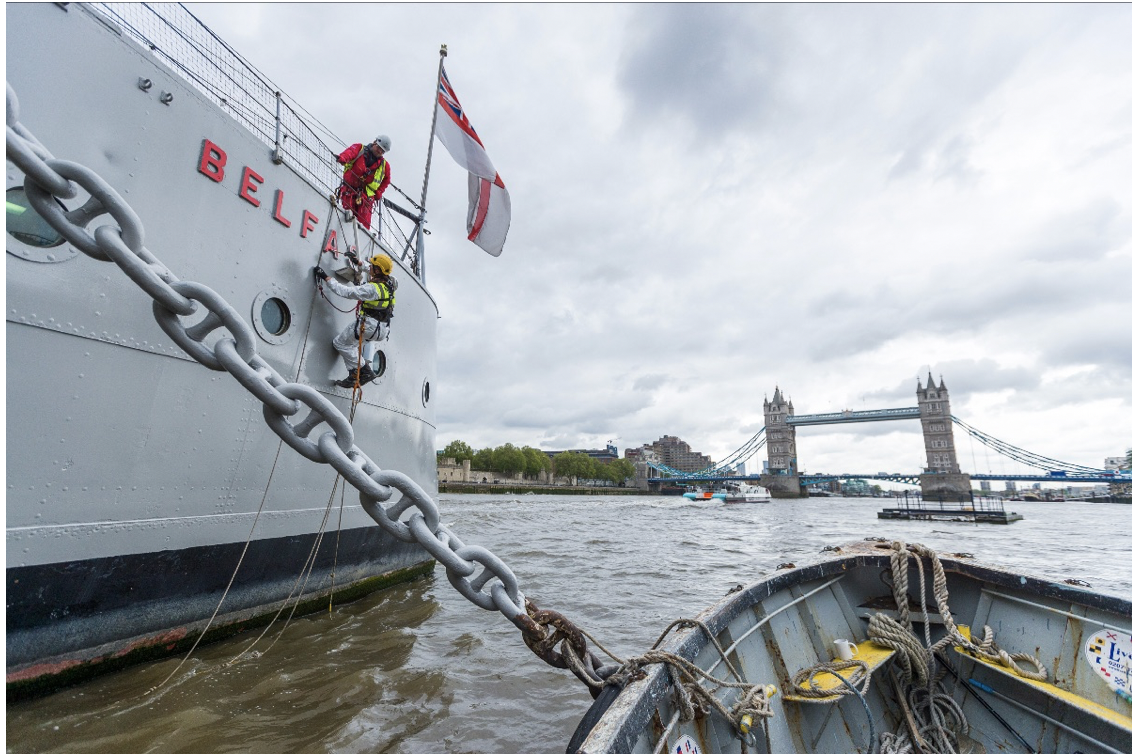Jotun UK & Ireland are working alongside Imperial War Museums supporting vital conservation work on HMS Belfast, one of the largest and most powerful cruiser in the Royal Navy during the Second World War, and now a floating museum on the Thames in the heart of London.
HMS Belfast’s construction began in 1936 by Messrs Harland & Wolff and was launched on St Patrick’s Day 17 March 1938. She was commissioned into the Royal Navy on 5 August 1939 less than a month before the start of the Second World War. After a mere two-month service, extensive hull damage from a magnetic mine left her in dry dock for three years.
Rejoining the fleet in 1942 until April 1944, she worked the Arctic convoys for much of the rest of the war, protecting the key supply route to Russia and playing an important role in the sinking of the German Battleship Scharnhorst. From 6 June – 8 July 1944, HMS Belfast spent five weeks supporting the D-Day landings and is said to have fired one of the first barrages at Gold and Juno beaches on D-Day.
Before being retired from service in 1963, HMS Belfast was also actively involved in the Korean War from 1950 – 1952, as well as serving in a peace-keeping capacity around the world.
As such a valuable asset in British and Commonwealth history, it was only right that she be saved from the scrap heap and in 1971 was brought to London by the HMS Belfast Trust to become a floating museum. She was transferred to the guardianship of IWM in 1978, where she remains today.
A sizeable donation of paint from Jotun will ensure that the historic vessel’s structure is soundly protected and cosmetically restored to its original condition for current and future generations to explore and learn about. To equip HMS Belfast for her ongoing battle against the elements, Jotun have supplied advanced two-pack coatings enabling the restoration to be carried out successfully by brush and roller application. The challenging conditions posed by its location on the River Thames in the center of London prohibit conventional spray application and ensuring long term performance was imperative.
Tim Sexton, UK marine manager, said: “Supporting this project was a very easy decision for us in Jotun. This vessel means so much to the history of the UK. We chose the products based on ease of use and the long-term protection properties required for this iconic vessel and the choices were very much appreciated by the Owners and Applicators applying the products in the middle of the River Thames.”
Conservation work is permanently on going. Forming part of a ship tour and an open-door attitude to workshops allows the public to see what it takes to keep a war ship in shipshape condition. However, the Covid Lockdown closure has provided an opportunity for some of the heavier maintenance jobs to be tackled, such as the exterior paint work.
Dr. Andrew Higgins, director of development at IWM, said: “When it came to paint, product suitability and track record, alongside an ability to match the specific colours required to return HMS Belfast back to her original Second World War look were top of the agenda. Given the dramatic drop in commercial revenues due to the global pandemic, the cost savings to IWM from this generous in-kind support was very much appreciated and marks the start of a new partnership with Jotun and IWM.”
HMS Belfast has re-opened to the public and tickets can be booked via https://www.iwm.org.uk/visits/hms-belfast
To find out more about the Jotun paint range visit https://www.jotun.com/uk/en/b2b














